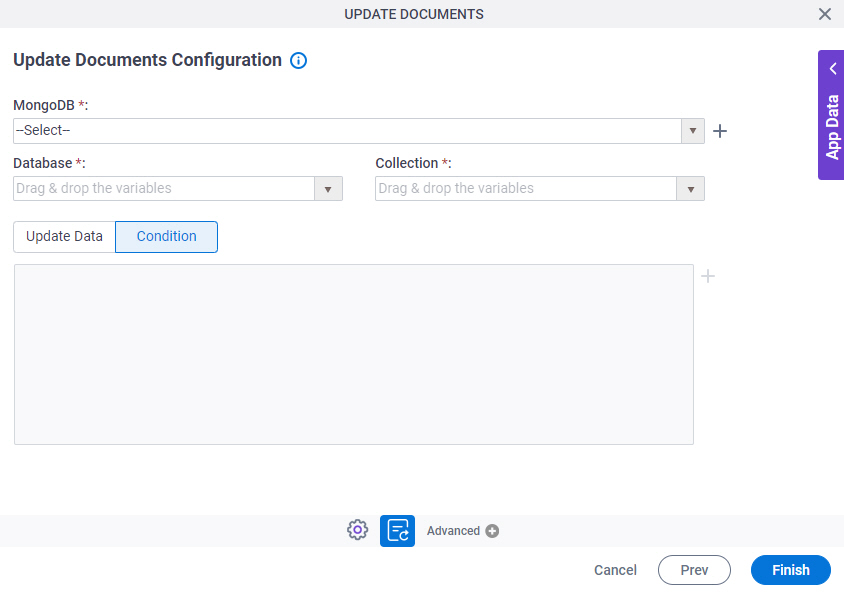
- Update document in collection options arangodb update#
- Update document in collection options arangodb driver#
- Update document in collection options arangodb code#
REST interface are abstracted by the client library. The library user does not have to care about this fact as all the details of the When exchangingĭocument data with the server, the library internally uses the With documents and collections in an object-oriented fashion. The client library provides document and collection classes you can use to work Written in PHP and has no further dependencies but just plain PHP 5.6 The ArangoDB PHP client is an API that allows you to send and retrieve documentsįrom ArangoDB from out of your PHP application. The autoloader can be nested with other autoloaders. The autoloader cares about loading additionally required classes on To use the PHP client, you must include the file autoloader.php from the mainĭirectory. There is an example for this kind of statements in the There is an example for REST-based documentsĪccess in the examples/document.php file.įurthermore, the PHP client also allows to issue more AQL complex queries using
Update document in collection options arangodb driver#
Shard key, as this allows the lookup to be restricted to a single shard.This driver for ArangoDB, called the ArangoDB-PHP client,Īllows REST-based access to documents on the server.

Ideally, the search expression contains the The lookup attribute(s) from the search expression should be indexed in order IntermediateCommit thresholds for data and operation counts. In order to avoid this issues you can increase the Would hit the same document multiple times, and only if you have large This will only be an issue if you write a query where your search condition Have the side-effect that atomicity of this operation cannot be guaranteedĪnymore and that ArangoDB cannot guarantee to that read your own writes in This intermediateĬommit will write the data that has been modified so far. UPSERT over all documents inĪ collection) an intermediate commit can be triggered. Using very large transactions in an UPSERT (e.g. Helps avoiding conflicts but is bad for throughput! It is equal to the shard key attribute of the collection or at least containsĪn alternative to making an UPSERT statement work atomically is to use theĮxclusive option to limit write concurrency for this collection to 1, which Note that in the cluster a unique index can only be created if To prevent this from happening, one should add a unique index to the lookupĪttribute(s).
Update document in collection options arangodb code#
Note that due to this gap between the lookup and insert/update/replace,Įven with a unique index there may be duplicate key errors or conflicts.īut if they occur, the application/client code can execute the same query May all determine that the target document does not exist and then This means if multiple UPSERT queries run concurrently, they The lookup and the insert/update/replace parts are executed one afterĪnother, so that other operations in other threads can happen inīetween. Transactional, especially if it involves different shards and/or DB-Servers. That behavior can be controlled by adjusting the intermediateįor sharded collections, the entire query and/or upsert operation may not be In this case, the query’s operationsĬarried out so far will be committed and not rolled back in case of a laterĪbort/rollback. Query) hits the specified size thresholds. If the RocksDB engine is used and intermediate commits are enabled, a query mayĮxecute intermediate transaction commits in case the running transaction (AQL On a single server, upserts are executed transactionally in an all-or-nothing UPSERT searchExpression INSERT insertExpression REPLACE updateExpression IN collectionīoth variants can optionally end with an OPTIONS Transactionality
Update document in collection options arangodb update#
The syntax for upsert and repsert operations is: UPSERT searchExpression INSERT insertExpression UPDATE updateExpression IN collection Traversal operations, or AQL functions that can read documents. It cannot be followed by read or write operations that access the same collection, by


Only a single UPSERT statement per collection is allowed per AQL query, and The UPSERT keyword can be used for checking whether certain documents exist,Īnd to update/replace them in case they exist, or create them in case they do not exist.Įach UPSERT operation is restricted to a single collection, and the


 0 kommentar(er)
0 kommentar(er)
